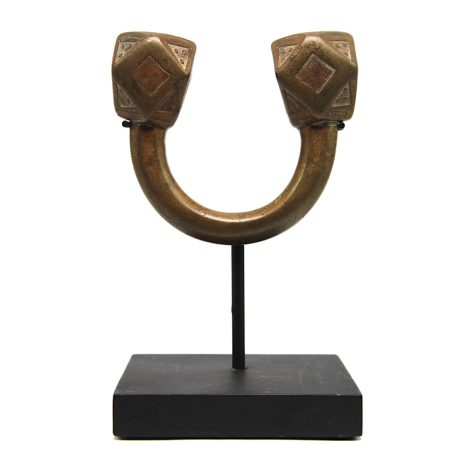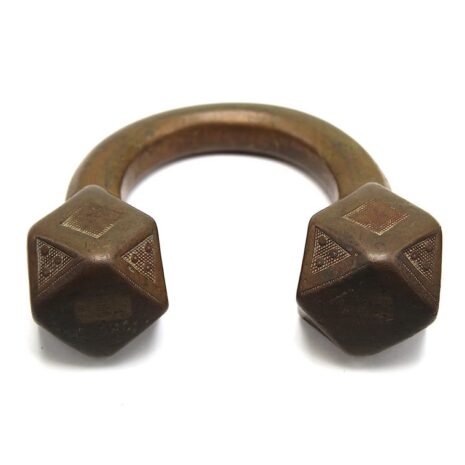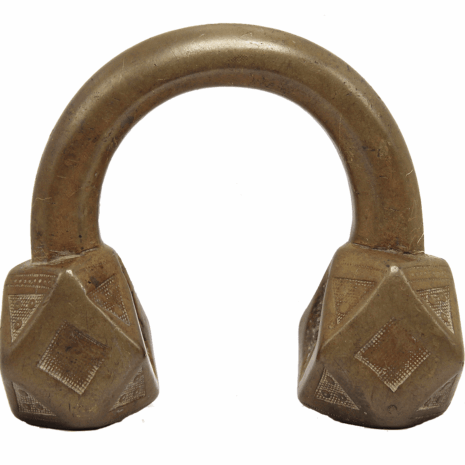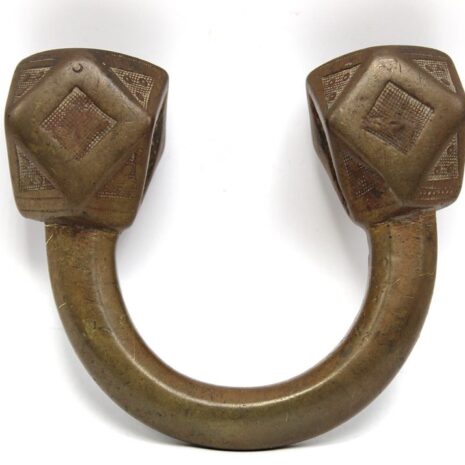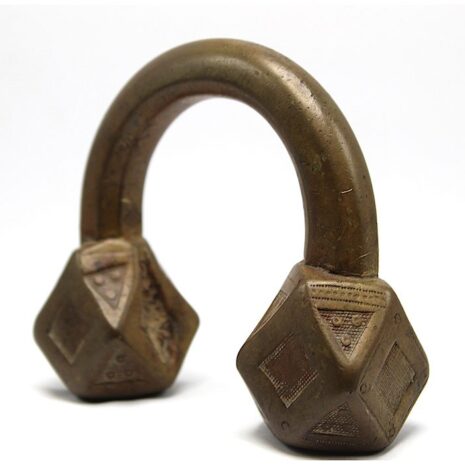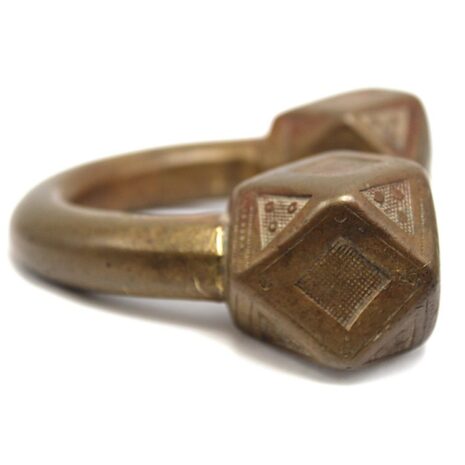Antique Tuareg King Manilla, North/West Africa, (3161)
Original price was: $325.00.$295.00Current price is: $295.00.
Ht: 4″ W: 4.6525″ Thick: 1.5″ Circum: 10.5″ | FREE SHIPPING WITHIN CONTINENTAL U.S.
Antique horseshoe shaped Tuareg “King” manilla, magnificent metalwork, 10 faceted flat finial ends with traditional etched and hammered geometric designs, excellent condition, fine patina.
Description
Two million Tuareg herders were historically nomadic peoples traversing the Sahel and Sahara Desert in North African countries of Mali, Niger, Libya, Algeria, Chad and West African Burkina Faso. With a rich metalwork tradition Tuareg artisans created brass and copper bracelets that were easily portable for nomadic populations, as symbols of wealth and status; fashion adornments; ceremonial pieces and storing and exchanging wealth. Tuareg group used unique African Art symbols and decorative motifs passed down for generations. Followings Islam, they are prohibited from creating figures and instead use abstract geometric designs. As explained by Dassine Oult-Yemma, Poet of the Ahaggar, sticks indicate legs of men, camels and other animals, crosses or x’s indicate guiding signals at roads and circles have a spiritual meaning. “We start from our heart, and move from circle to circle ever more widely, into the Circle of Life, like the horizon circles around you and your herd.” (Hagan and Meyers).
During the colonization of Africa in the 1500s, the British, French, Portuguese, Belgians and Dutch appropriated African metalwork bracelets, manufactured their own versions in Europe and called them manillas. They became currency for the slave trade referred to as slave bracelets, slave trade money and slave currency to purchase slaves for American and Caribbean plantations. European-made manillas were used in African counties to trade for goods like ivory, spaces, palm oils as well as slaves. They were integral to the triangle trade of the time with England as the dominant force. England manufactured and used manillas to purchase slaves who were sent to the Americas where traders in exchange would ship cotton to Europe. Manillas were of diverse forms, quality, and sizes and varied in value and areas where they could be used. For instance, in Nigeria in the late 1800’s 5 different forms of were used. Although manillas were primarily made by colonial western nations after the 16h century, the Tuareg historically continued to create manilla-like pieces for their cultural and economic systems. Prohibited for use by foreign traders under the Manilla Currency Ordinance of 1919, during1940s and 50’s they were confiscated and melted down. Manillas are still worn by slave descendants in the Caribbean as family treasures to pass on to future generations.
Tuareg King Manillas were used not only in the slave trade but also all over the world to trade in European goods. This 19th century Tuareg “king” manilla bracelet/anklet made from brass, copper and iron was fashioned using a sand mold for a one-of-a-kind piece. King manillas are horseshoe shaped, typically less curved than smaller manillas. Composed of massive flat finials with 10 facets with raised diamond shapes and fine hand-etched and hammered cross-hatched designs and triangles with raised circles. King Tuareg bracelets like this were often forged in Africa by Tuareg metal smiths, never worn and used for trade and status purposes. In excellent condition with appropriate signs of age and use and comes with a wood and metal stand.
Click here for the Blog Manillas: Former African Trade Currency.
Sources
Helen E. Hagan and Lucile Meyers, Tuareg Jewelry: Traditional Patterns and Symbols, Xlibrus Corporation, 2006.
Additional information
| Place of Origin | Africa |
|---|---|
| Period | Antique (1200-1920) |
| Date | 19-20th Century |
| Materials and Technique | Bronze/brass/copper alloy |
| Dimensions (inches) | H: 4” W: 4.625” Thick: 1.5” Circum: 10. 5” |
| Dimensions (metric) | H: 10.16 cm W: 11.73 cm Thick: 3.81 cm Circum: 25.78 cm |
| Weight | 22.9 oz |
| Condition | Excellent, fine patina demonstrating age and use |
| Item Number | 3161YOE |
| Shipping Box Size |

